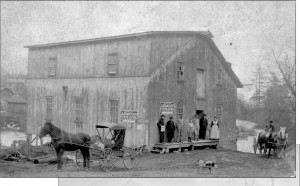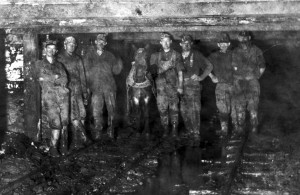The history of Grove City begins in 1798 when Valentine Cunningham settled along the banks of Wolf Creek. Cunningham, his wife Margaret, and their children left Huntingdon County and became the first of European ancestry to permanently settle in the area that would become Grove City. In 1799, he built the first gristmill in the area. This occurred several years before Mercer, Erie, Crawford, Warren, and Butler Counties were created out of lands from Allegheny County. The Cunningham’s stay here was profound yet tragically short. Margaret Cunningham died in 1800, just two years after settling along Wolf Creek. Mr. Cunningham died in 1806, six years after his wife’s passing. However, the importance of the settlement that Cunningham founded was quickly evident.
Cunningham’s mill was constructed just upstream from the current Main Street Bridge over Wolf Creek. A few years later, another mill was built near where Route 208 crosses Wolf Creek. The economic activity in this corner of the county prompted the building of a road connecting the newly created county seat, Mercer. This roadway would eventually become part of PA 58, one of northwestern Mercer County’s more important secondary highways. In the 1830s, the sons of Valentine and Margaret, Charles and James B. Cunningham, returned to the community of their childhood. This was an exciting time in the growth of the town. The first educational establishment, a subscription school, and some of Grove City’s oldest churches were founded during this time. During the same period, the Cunningham brothers formally laid out the community, naming it Pine Grove.
The town would remain as it was for the next several decades: a small, rural town, serving the commercial needs of local farmers, tradesmen, and residents. It took two incidents for Pine Grove, which had 200 residents in 1870, to grow. The town needed a reason for people to come and a way for people to get there. When coal was discovered in vast quantities in the region, many people settled in Pine Grove and the surrounding townships. It literally fueled local growth. It also powered the vehicle of all national growth in the mid-to-late 1800s the railroad.
When the Borough was created from Pine Township, it was necessary to change the community’s name, since another coal mining community named Pine Grove was already incorporated as a borough in Schuylkill County in eastern Pennsylvania. It was at this time that the area first settled by the Cunningham’s officially became known as Grove City. The community grew rapidly for the next several decades. By 1920, the population approached 7,000 people. New industry came into town, complementing the mining operations in the surrounding townships.
As both the Borough and the region grew, Grove City became the commercial center for the local area. Many businesses grew and prospered, supplying the residents with all their needs. It was said of one such purveyor that his horses knew his Saturday evening delivery route so well, he did not need to drive the team. Instead, he tossed his deliveries out the back of the wagon as the horses plodded from one customer to the next. While the Grove City of the late 19th and early 20th centuries was a bumptious place, the seeds of its refining elements had already been planted. The church community grew and prospered with the founding of new congregations and the expansion of existing ones. Public schools became an important part of the community. Some of Grove City’s earliest schools sat at the corner of Main and Center Streets. The McDonald’s restaurant that occupies this corner pays homage to this chapter of the town’s history with a small memorial to the former schools.
The Borough matured from the end of World War I until the 1970s. Numerous industries existed in the borough, providing steady employment and the financial underpinning for a vibrant downtown commercial district. In the 1970s, however, economic change was sweeping the United States. Western Pennsylvania was devastated. Old time industries, which had been part of communities for decades, either closed individual plants or went out of business completely. By the early 1980s, this economic upheaval was at its apex. Mills and factories closed all around the country. It was the same for Grove City. Long-time businesses left town, leaving a large portion of the population unemployed. As the mills and factories closed, other local businesses, both commercial and professional, lost customers, forcing many to cease operation. The impact of this severe recession was the most profound of any downturn since the Great Depression of the 1930s.
Still, the resilient spirit of Grove City shimmered through. Today, numerous employers call Grove City and the surrounding area home. The General Electric Diesel Engine Plant is a sizable operation located at the western edge of town. It employs several hundred persons. Grove City College, rated as one of the nation’s finest small liberal arts schools, is as unique and resilient as the rest of the town. The downtown business district, which in other communities might have been boarded up and forgotten, continues to serve the town and region as a service, as well as retail center.




